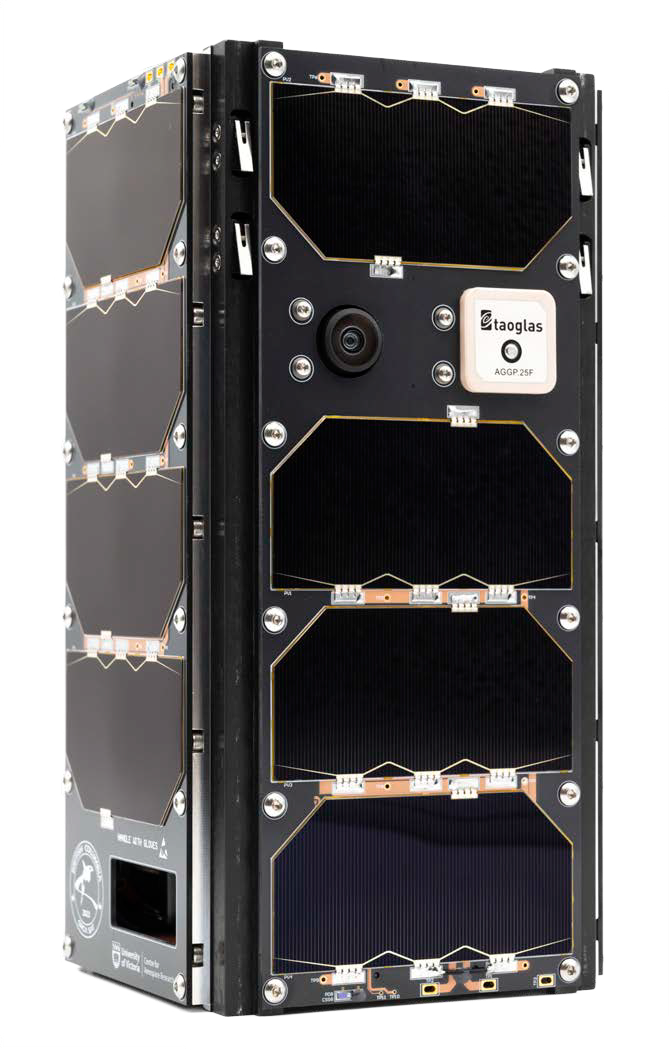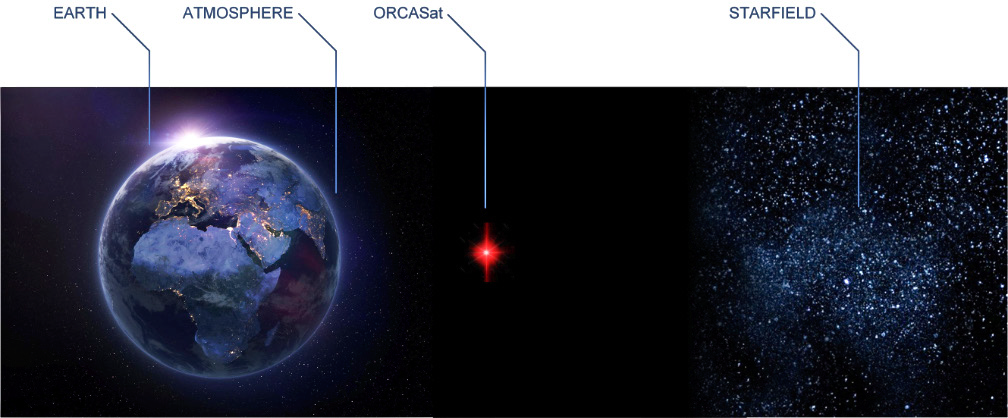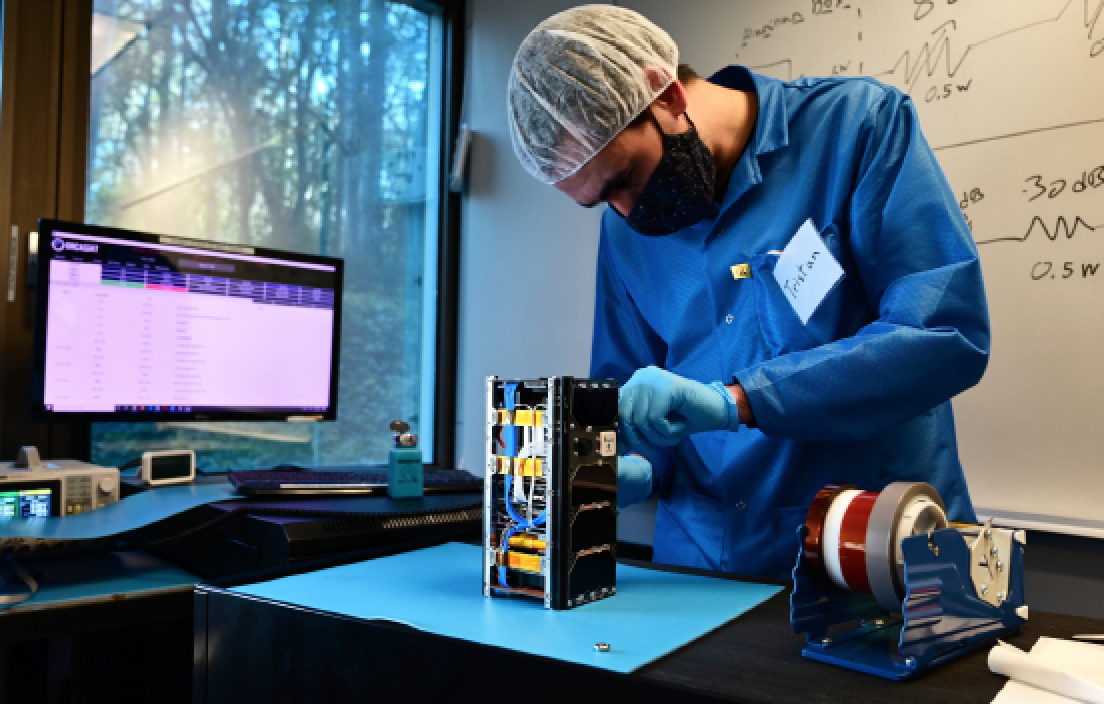The Optical Reference Calibration Satellite The Optical Reference Calibration Satellite
The Optical Reference Calibration Satellite (ORCASat) is a 2U CubeSat (a satellite 227 x 100 x 100 mm, roughly the size of a tissue box), that is designed and built in-house by students at the University of Victoria (UVic) Centre for Aerospace Research.
 ORCASat flight and engineering models during assembly.
ORCASat flight and engineering models during assembly.
The ORCASat mission has two primary objectives:
A. Train Highly Qualified Personnel (HQP) in space science and technology by providing an unrivaled, hands-on learning experience for undergraduate and graduate students.
B. Demonstrate new technologies for calibrating Earth-based telescopes by providing a reference light source in orbit.
The ORCASat science mission summary:
• ORCASat is an orbiting light source that can be viewed by ground-based telescopes.
• ORCASat measures how bright its light source is.
• Ground-based telescopes can measure how bright ORCASat appears.
• Once corrected for altitude and attitude, the difference between how bright ORCASat is and how bright it appeared to the telescope is the amount of light attenuated in the atmosphere and telescope optics.
• Telescope is now calibrated for absolute brightness and can take more accurate measurements of astronomical objects.
How does the ORCASat project train HQP?

ORCAsat team photo ORCASat team in September 2021.
All HQP involved in the project start as university students (undergraduate and graduate) that contribute to the development of ORCASat and/or day-to-day mission operations by volunteering or working full-time as part of co-operative education programs.
Some members have graduated and continue to work full-time as researchers to gain further experience in space science and technology by designing, manufacturing, testing, and operating a custom-built spacecraft to complete the science objective.
What is the science objective of ORCASat?
Ground-based telescopes measure how bright astronomical objects appear to be, not how bright they actually are. When observing astronomical objects, the light that is measured passes through the atmosphere and the optics of the telescope.
These mediums cause the light to be attenuated, and the exact amount is difficult to determine. By the time the light reaches the telescope’s sensor, there is an uncertainty on the measurement due to the attenuation of light from the atmosphere and optics.
There are good atmospheric models that can predict how much light is lost, but there is still a significant component of the atmosphere which changes rapidly (aerosols) and its contribution to the attenuation of light passing through it is difficult to predict using existing models.
ORCASat will demonstrate that ground-based telescopes can be calibrated for this undesirable attenuation by providing a reference light source in orbit that can be viewed by a telescope on Earth.

ORCASat satellite view from the zenith-pointing face
with antennas stowed.
ORCASat is carrying two laser light sources and it is able to measure the amount of light (the radiant flux) that these light sources are emitting. Astronomers can measure how bright ORCASat appears, just as they would an astronomical object.
At the same time that a telescope is measuring the light from ORCASat, the satellite will measure how bright it actually is — the satellite also measures its altitude (how high it is above sea level), attitude (where it is pointing in space), position (where above Earth), health of the spacecraft, and health of light source.
ORCASat is also carrying a GNSS receiver that allows it to sync the clock on the spacecraft to UTC to ensure the measurements from the satellite have accurate timestamps. From this data, the astronomers can use models to determine how bright ORCASat should have appeared to the telescope on Earth.
The difference between how bright ORCASat appeared to the telescope, and how bright it should have appeared, is the amount of light that was attenuated by the atmosphere and/or the telescope optics. Once this is characterized, the telescope can then take more accurate measurements of the absolute brightness of astronomical objects.
The ORCASat light source is SI traceable, meaning the absolute brightness and spectrum of ORCASat is well understood and characterized. This is the first satellite ever to carry a light source capable of performing this experiment to this level of absolute accuracy.
Why is the absolute brightness of astronomical objects important?
The absolute brightness of astronomical objects is important to many areas of research, but one application of particular interest for the ORCASat mission is to reduce the uncertainty of measuring the accelerating expansion rate of the Universe. These measurements can be performed by surveying the absolute brightness of Type 1a supernova (SN1a).
The brightness of these supernovae tell us how far away they are, and from that we can determine how fast they are moving away from us. If we know how fast astronomical objects are moving away from us, then we can measure how fast the universe is expanding. ORCASat will be able to further reduce the uncertainties on how bright these supernovae are, and demonstrate that this method will increase the accuracy of universal expansion rates.
 ORCASat mission concept diagram.
ORCASat mission concept diagram.
What is the light source onboard ORCASat?
ORCASat is carrying a custom-designed light source as a payload. This payload consists of:
• Laser light source 1: 120 mW 660 nm laser (Oclaro HL65051DG), constant power driver.
• Laser light source 2: 175 mW 840 nm laser(Thorlabs L840P200), constant power driver.
• Integrating sphere: 5.08 cm (ID), 1.27 cm (ID) exit port, and a sphere multiplier of ~17.
• Photodiode 1: Hamamatsu InGaAs G10899-03K photodiode.
• Photodiode 2: Hamamatsu Si S12698-01 photodiode.
• Temperature sensors: laser diodes, photodiodes, and electronics.
• Laser current sensors.
Transimpedance amplifier: Custom transimpedance amplifier electronics to convert photodiode photocurrent into a digitized value that can be downlinked from the satellite.
The ORCASat payload light source has been calibrated at the National Research Council Canada via their Photometry and radiometry calibration service. The payload light sources are programmable and can operate for up to 30 seconds with the TIA sampling at 1000 kHz.
Longer illumination times can be programmed if the sampling rate of the TIA is reduced. The payload can either pulse or leave both of the light sources individually or simultaneously. The pulse profiles for each laser can be different. The lasers can also be dimmed down to about 10% of their rated output power.
How will ORCASat operate once in space?
Once the satellite is ejected from the Nanoracks CubeSat Deployer outside the ISS, it requires 35 minutes in sunlight to turn on and start its deployment sequence. Operators then use the Three Line Element (TLE) provided by Nanoracks to estimate when it will next be overhead the ground station at the University of Victoria, so they can attempt to make contact with the satellite.
The initial contact is made as part of the commissioning process, which involves performing health checks and using the attitude control system to detumble and point the payload toward Earth. Estimated commissioning time is two weeks.
After successfully being commissioned, the satellite is placed into standby mode and waits for operators to command the satellite. At this point, astronomers can submit requests to turn the light source on when it is overhead the target telescope.
Orbital propagation tools in combination with Celestrak TLEs and on-board telemetry from the GNSS receiver are used to determine the next time ORCASat will be overhead the target telescope. The satellite operators then uplink time-tagged commands to ORCASat to schedule the payload operation at the requested time with the desired configuration settings.

Mechanical Lead Tristan Tarnowski, attaching cable
harnesses on the ORCASat satellite.
After the payload operation is complete, the data generated by the payload and satellite is downlinked by the operators, decoded, parsed, and stored in the database at UVic. Once the operators have determined the pass was successful, the human-readable telemetry is made available to the astronomers for post-processing and analysis.
ORCASat is designed for one payload operation per day, but it can operate at a much higher duty cycle for the majority of its lifetime. The main constraint is just access time with the UVic ground station, but the satellite can store a significant amount of data on-board and it can be downlinked over multiple passes of the UVic ground station. As this is a technology demonstration and not a service, it is not expected to be operating frequently, i.e. multiple times per day for the majority of the mission life.
Why is ORCASat important? ORCASat will demonstrate new technologies to calibrate ground-based telescopes and increase the measurement accuracy of the absolute brightness of astronomical objects. Not only will ORCASat demonstrate these exciting new technologies to advance astronomy, but ORCASat space and ground segments are custom designed for the mission entirely by students.
This is a monumental engineering achievement and the ORCASat alumni have unique and extremely valuable hands-on experience from their contributions to the ORCASat project. More than 20 full time co-operative education students have gained experience from working on ORCASat.
More than 100 part-time volunteer students have contributed to ORCASat and learned about space mission design. This number we expect to continue to grow after the spacecraft is launched and students gain experience with day-to-day mission operations and flying the satellite.
The ORCASat project is growing the next generation of Canadian space scientists, engineers, and entrepreneurs in British Columbia that will change the future of the space industry in Canada.
What is the status of the ORCASat project?
As of November 26, 2022, the ORCASat flight unit has launched to the International Space Station on-board a Falcon 9 rocket as part of the NASA/SpaceX CRS-26 mission. ORCASat was deployed into orbit from the ISS via the Nanoracks CubeSat Deployer on December 29, 2022.
A few hours after deployment, the team at UVic contacted the satellite using a custom-built, amateur radio ground station. After first contact, the team requires a few weeks to commission the satellite and confirm everything is operational and the satellite is healthy. After that, it’s just monitoring the satellite and using the payload to do some exciting science!
More information about the science case behind ORCASat
The ORCASat science mission is inspired from the work done on the ALTAIR Project.
Co-Principal Investigator for ORCASat, Prof. Justin Albert, is using weather balloons to fly a larger and more sophisticated version of the ORCASat light source, known as ALTAIR. Please visit the following references...
[1]“Airborne Laser for Telescopic Atmospheric Interference Reduction (ALTIAR),” ALTAIR Project. [Online]. Available: http://projectaltair.org/. [Accessed: 12-Jul-2022].
[2]Albert, J. E., Fagin, M. H., Brown, Y. J., Stubbs, C. W., Kuklev, N. A., and Conley, A. J., “Precision Calibration via Artificial Light Sources Above the Atmosphere”, arXiv e-prints, 2012.
[3]Stubbs, C. W. and Tonry, J. L., “Toward 1% Photometry: End-to-End Calibration of Astronomical Telescopes and Detectors”, The Astrophysical Journal, vol. 646, no. 2, pp. 1436–1444, 2006. doi:10.1086/505138.

Author Alexander Doknjas is the project manager for the ORCASat project at the University of Victoria Centre for Aerospace Research.
All imagery is courtesy of the author.

